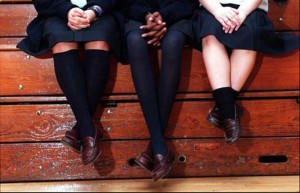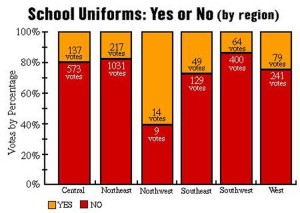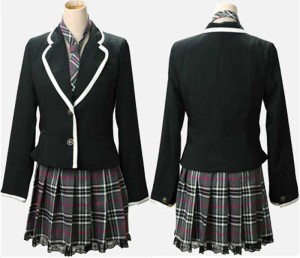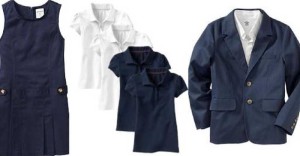To Match or Not To Match

The debate over uniforms versus public dress code brings out a variety of opinions throughout a school. Interviews from AAHS student and faculty members reveal strong opposing ideas on how uniforms would affect Air Academy’s atmosphere. To clarify, uniforms are not in question for AAHS, yet opinions about uniforms are prominent. Uniforms could bring more peace, equality, motivation, and better priorities for AAHS, or they could highlight other differences and issues amongst students.

PRO: Faculty members bring up an important profitable position on how uniforms cost less and are lower maintenance. Joan Nachbar, the Principle’s Administrative Assistant, says, “Uniforms would help families with low income for their children not to feel discriminated against, and provide a way for them to fit in.” According to the US Department of Education, 49% of parents and 86% of teachers say uniforms are financially beneficial for households; School Uniforms Examiner, Matt Buesing, records an average of about $700 spent on public school dress yearly while uniforms only average yearly as about $300.
CON: On the other hand, families with less income can benefit from places like Goodwill that provide cheep, regular clothes for them, but, with uniforms, those families are forced to pay for high quality shirts, pants, and possibly shoes.

*Copyright to 2013 Download High Definition Wallpapers 2013
PRO: Based on a regular public dress code, Air Academy Principal Toria McGill says, “Some kids feel a lot of pressure to dress a certain way or to buy a certain brand… Kids who can’t afford to dress stylishly can feel left out or can even be bullied about their dress.” Eliminating expensive trends may be a better way for redirecting students’ attentions and efforts more towards their education. 81% of teachers from schools using uniforms believe the uniforms improved learning and the environment while 95% saw more positive student behavior (US Department of Education).
CON: Randomly selected students, however, revealed that switching to uniforms at AAHS would restrict their freedom of expression that most public schools provide. By doing this, students would not have the ability to express their personalities through their styles, and some students value this freedom. When AAHS sophomore Mike Greenbaum was asked if he believes uniforms to be a good idea, he said, “No because I want freedom of expression.” Also, uniforms can give students the impression that in order to be accepted, they need to look the same.

CON: Having such little “wiggle room” in what students can choose to wear, such as shoes or jewelry, would lead to more focus around the brand or style of that accessory. For example, according to AAHS students, if a student doesn’t wear Vans or sparkly Toms, that student becomes “less cool.” Adults sometimes underestimate the significance a social life can have on a student; “drama,” possibly caused by the style difference and social structure, can create a barrier between the student and his or her education. It can burden the student, which then affects how well he or she may participate or excel in his or her classes. It may not seem a big deal, but if continued, there could be long-term effects on the student’s education.

Our principal, Mrs. McGill, says, “I think this would be a huge culture change for AA. Instead of putting a lot of energy into that kind of culture change, I hope we put more energy into teaching tolerance, respect, kindness, and that a person’s appearance is less important than a person’s character.” Perhaps the answer lies in what impact, positive or negative, that uniforms have had in other public schools that have made the switch, but we cannot necessarily attribute student attitude and performance solely to their dress.



